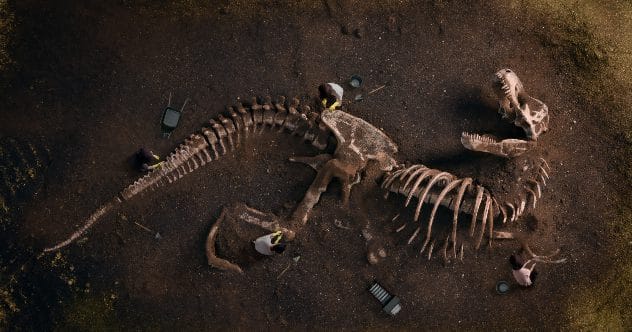Dinosaurs! The very word conjures images of colossal creatures roaming a prehistoric Earth. We’re captivated and, let’s face it, a little terrified by these ancient giants. But how much of what we know about dinosaurs is fact, and how much is Hollywood fiction? As scientists continue to dig up new discoveries, our understanding of these amazing animals constantly evolves. Prepare to have your dino-beliefs challenged!
Forget the scaly, green monsters popularized by movies like “Jurassic Park.” Real dinosaur research reveals a much more complex and fascinating picture. From feathered dinosaurs to teens reproducing to avoid extinction, the reality is far more surprising than fiction. Here are 10 astonishing dinosaur facts that might just change how you see these incredible creatures.
1. Dinosaurs Grew Up Super Fast
When it comes to growth in nature, there’s no one-size-fits-all approach. Each species has its own unique growth pattern. The massive dinosaurs we know and love achieved their immense size through rapid growth spurts, a crucial survival tactic since they didn’t live very long as adults. It was a race against time: grow big, and grow fast!
Titanosaurs, the true heavyweights of the dinosaur world, were four-legged herbivores that tipped the scales at a staggering 90 tons—that’s about 25 adult elephants! These gigantic reptiles hatched with almost adult-like proportions. Another fast-growing dinosaur was the Mamenchisaurus, an herbivore boasting a 35-foot-long neck. It took this giant roughly 30 years to reach a length of 70 feet. Even the mighty Tyrannosaurus rex experienced a huge growth spurt during its teenage years, unlike other species that grew slowly over time.
2. Dinosaurs Never Really Went Extinct
Dinosaur enthusiasts will tell you that dinosaurs are still around; you just have to look up! Believe it or not, research shows that dinosaurs live on in the form of birds. That’s right, the feathered friends we see every day are actually descendants of dinosaurs!
In the 1960s, paleontologists discovered the Deinonychus, a carnivorous dinosaur from the early Cretaceous period. This species shared remarkable similarities with birds: they were bipedal (walked on two legs) and possessed deadly, sickle-like talons. They used their tails for balance while running to attack prey. Fossils reveal that the bodies of bird ancestors shrank over millions of years as they adapted to their changing environment. While imagining a Tyrannosaurus rex shrinking into a bird might seem far-fetched, it’s important to remember that evolution is a slow and gradual process. So, next time you spot a pigeon, remember its ancient and fearsome ancestors!
3. Some Dinosaurs Were Brainier Than Others
When it comes to brains, dinosaurs weren’t all created equal. Researchers generally agree that the Stegosaurus was the least intelligent, while the Troodon was the smartest.
The Stegosaurus, a massive herbivore known for the large plates on its back and spiked tail, grew to about nine meters long. However, studies have revealed that its brain was only the size of a walnut! This small brain likely made it difficult for the Stegosaurus to outsmart predators, making its protective plates necessary. On the other hand, the predatory Troodon had stereo vision, speed, and large eyes, making it a formidable hunter.
Other intelligent dinosaurs include the chicken-sized compsognathus and the Deinonychus. In “Jurassic Park,” the Deinonychus is portrayed as being able to open doorknobs. While that might be an exaggeration, research suggests they were capable of strategizing and communicating.
4. Dinosaurs Lived on Every Continent
Dinosaurs were truly global citizens. During the Triassic period, around 230 million years ago, the Earth was one giant continent called Pangea. As Pangea broke apart, dinosaurs spread across the newly formed continents.
Fossil evidence confirms that dinosaurs lived on every continent, from Europe and the Americas to Africa and Asia.
5. An Asteroid Didn’t Kill All of the Dinosaurs
While the image of a giant asteroid wiping out all the dinosaurs is dramatic, it’s not entirely accurate. The asteroid impact in the Yucatan Peninsula was a major event, but it wasn’t solely responsible for the extinction of all dinosaurs.
About 66 million years ago, an asteroid struck the Earth, causing widespread chaos. The impact vaporized soot, triggered wildfires, and blocked sunlight from reaching the surface. This led to the extinction of about 76% of Earth’s species, including many plants, animals, and, of course, the dinosaurs. However, the process was gradual, and some species were already struggling before the asteroid hit.
6. Dinosaurs Came in Building-Sized and Chicken-Sized Versions
Forget the notion that all dinosaurs were gigantic monsters. Dinosaur sizes varied dramatically, from creatures as big as buildings to others as small as chickens!
The Titanosaur, standing at about 46 feet tall, is considered the largest dinosaur, capable of eating leaves from the tops of five-story buildings. The Sauroposeidon was equally imposing, standing at almost 42 feet. On the smaller side, the Lesothosaurus was about the size of a chicken. However, the smallest dinosaur discovered to date is the Oculudentavis khaungraae, which was about the size of a hummingbird!
7. Most Dinosaurs Were Actually Vegetarian
Movies often portray dinosaurs as ferocious predators, but research suggests that most were peaceful vegetarians. These plant-eating dinosaurs, such as Hadrosaurs, Ornithopods, and Sauropods, roamed the plains in search of vegetation. They traveled in herds to protect themselves from predators.
Of course, there were also carnivorous dinosaurs, like the Theropods, which hunted the herbivores. This predator-prey relationship helped maintain balance in the ecosystem.
8. Dinosaurs Weren’t Necessarily Cold-Blooded
While reptiles are generally considered cold-blooded, dinosaurs may have been neither cold-blooded nor warm-blooded. Instead, they might have been “mesotherms,” meaning they were somewhere in between. If they were fully warm-blooded, their immense size could have caused them to overheat.
The high growth rates and active lifestyles of dinosaurs suggest that they needed a significant amount of energy, supporting the idea that they were mesotherms.
9. Dinosaurs Likely Had Feathers, Not Scales
Birds are often associated with feathers, but it turns out that dinosaurs may have had them first. In 1996, scientists discovered the Sinosauropteryx, a theropod with feathers. This discovery supported the theory that many dinosaurs were feathered, not scaly, creatures.
While it’s still debated whether all dinosaurs had feathers, scientists believe that many meat-eaters did. These feathered dinosaurs are the direct ancestors of modern birds. So, if you love chicken, you might have been able to domesticate a Tyrannosaurus rex… if you could get over the whole “it might eat me” thing!
10. T. Rex Had Incredibly Powerful Teeth
The Tyrannosaurus rex often gets made fun of for its tiny arms, but those arms are no match for its monstrous teeth. The 45-foot-long beast had 10-inch-long teeth that it used to crush bone and tear through flesh. A special arrangement of dentine strengthened its teeth, allowing it to take bites of up to 500 pounds. That’s about the size of a fully grown Siberian tiger!
The Tyrannosaurus rex had a 4-foot-long jaw to accommodate its 60 teeth. So, while movies might exaggerate the Tyrannosaurus rex, it’s clear that it deserves its reputation as a fearsome predator.
The world of dinosaurs is full of surprises. From their unexpected growth spurts and feathered bodies to their living descendants in the form of birds, these ancient creatures continue to fascinate and challenge our understanding of life on Earth.
What’s the most surprising dinosaur fact you’ve ever heard? Leave your comment below!










